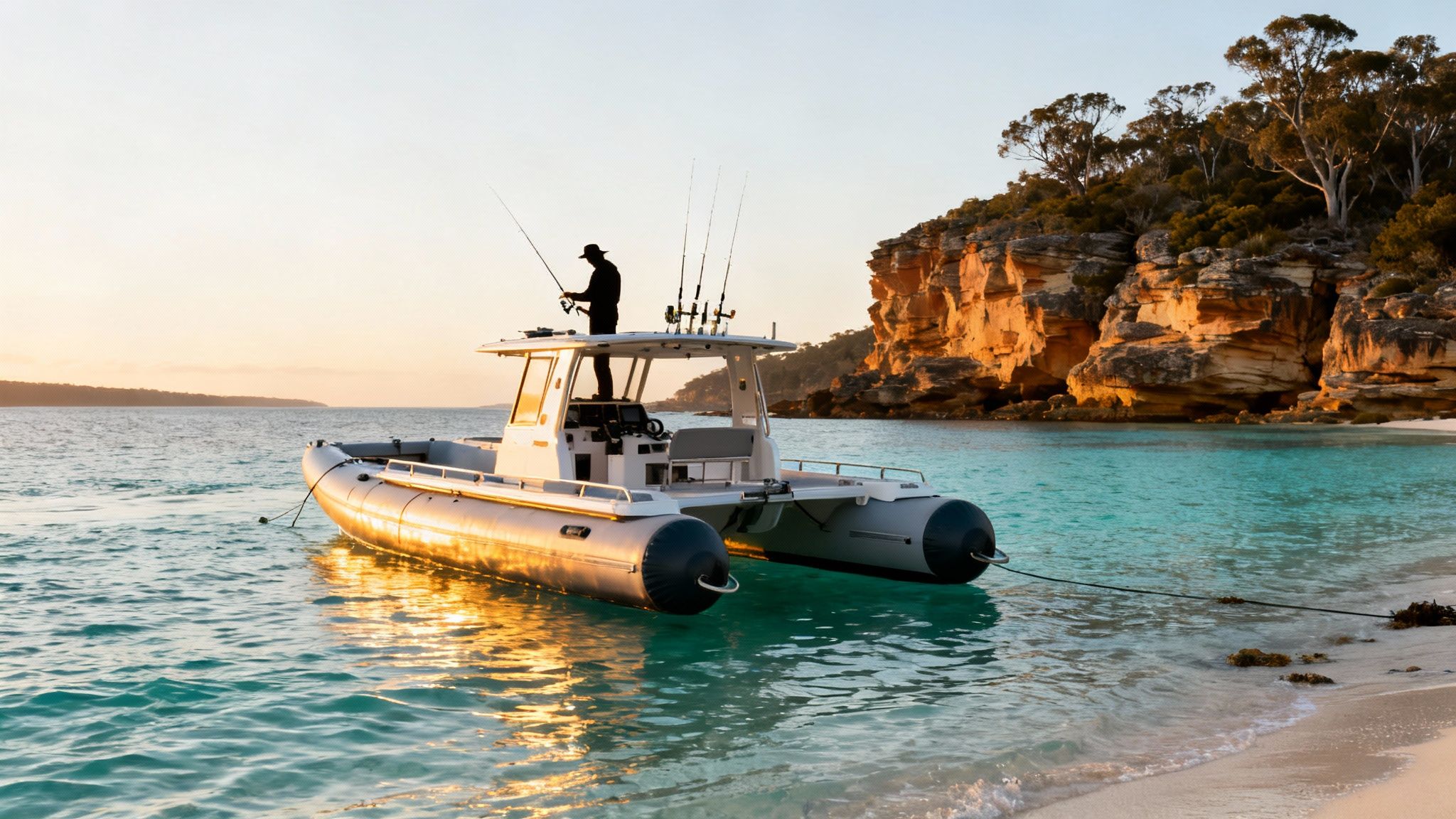
Buying used outboard boat motors is often one of the smartest moves an Aussie boater can make. Instead of paying top dollar for a brand-new model, the second-hand market lets you get a lot more horsepower for your money. It’s a great way to make the boating lifestyle far more accessible without a massive upfront investment.
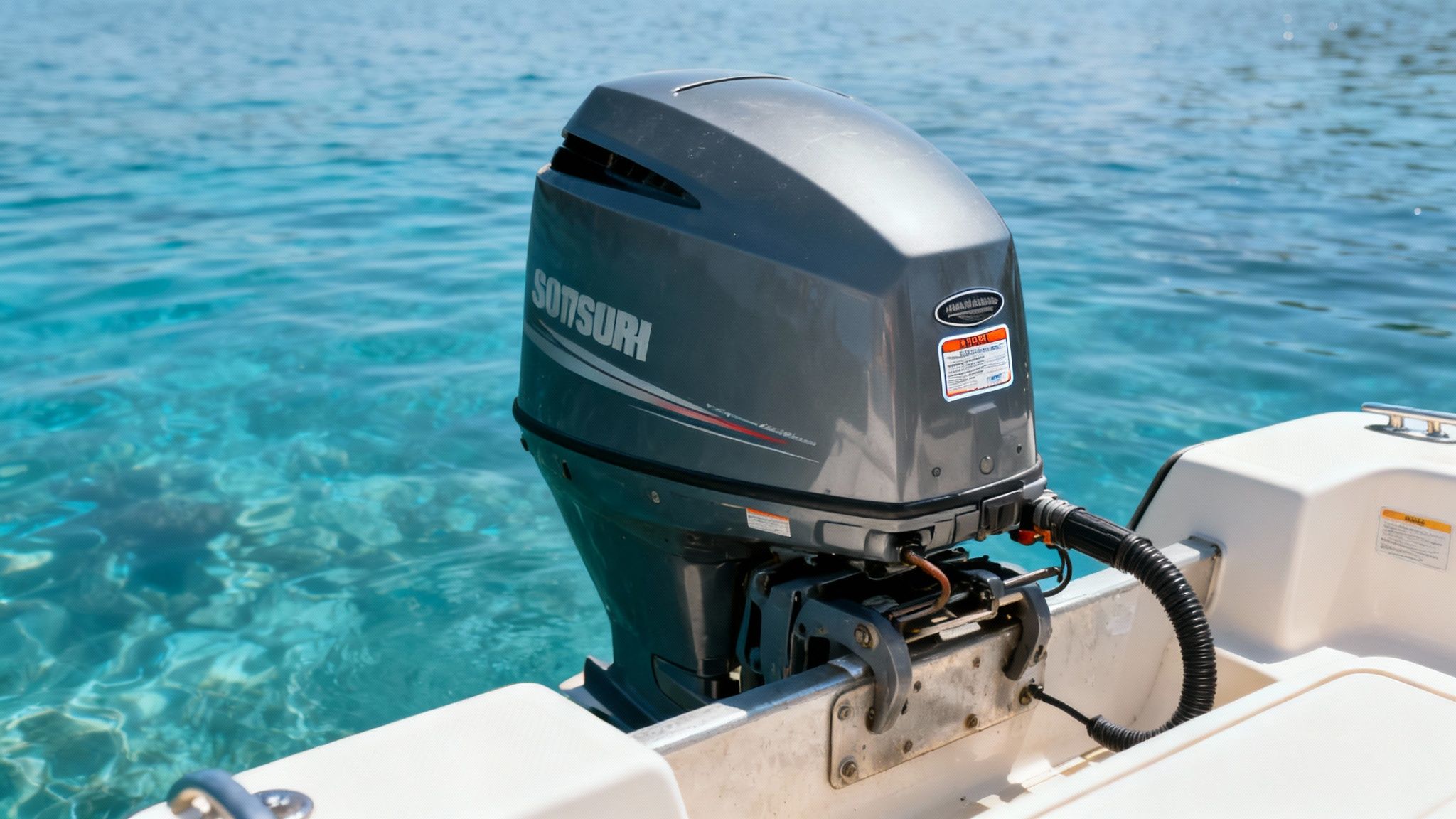
Let’s be honest, the idea of buying a used motor can feel like a bit of a gamble. But with the right approach, it’s a calculated decision that pays off in both savings and performance. This guide is here to help you move beyond the guesswork and give you real-world advice to confidently find a reliable motor that’ll power years of adventure.
The pre-owned market isn't just some small niche; it’s a massive part of Australia’s vibrant boating culture. The Australian marine equipment industry pulls in an estimated AUD 2.6 billion in 2024, and a huge chunk of that comes from pre-owned gear. In fact, dealers report that nearly 15% of their revenue comes from used boat sales and all the gear that goes with them, like outboard motors. That shows just how active this sector really is. You can dig into more insights on the Australian marine industry over at IBISWorld.
One of the best reasons to look at used outboard boat motors is the sheer value you get. Just like a new car, a new motor depreciates significantly in its first couple of years. When you buy a well-maintained, low-hour used model, you let the original owner take that initial depreciation hit.
This financial leg-up means you can often afford a more powerful or feature-rich engine than you could if you were buying new. For instance, the budget you have for a new 15hp motor might just get you a powerful, lightly used 30hp model that completely transforms your boating experience.
It’s not just about saving money; it’s about maximising what you can do on the water for every dollar spent. A bigger, better motor opens up a world of new possibilities for fishing, family days out, and exploring a lot further from shore.
While the big names like Yamaha and Mercury dominate the new market, the used scene offers a much wider variety of options. Brands like Hidea, known for their straightforward and tough-as-nails designs, represent excellent value.
When you start comparing used Hidea outboards, you'll often find newer models with fewer hours on the clock for the same price as an older, harder-worked competitor. This makes them a standout choice for boaters who want modern reliability without the premium price tag. For anyone on a budget, exploring these affordable outboard motors can be a real game-changer.
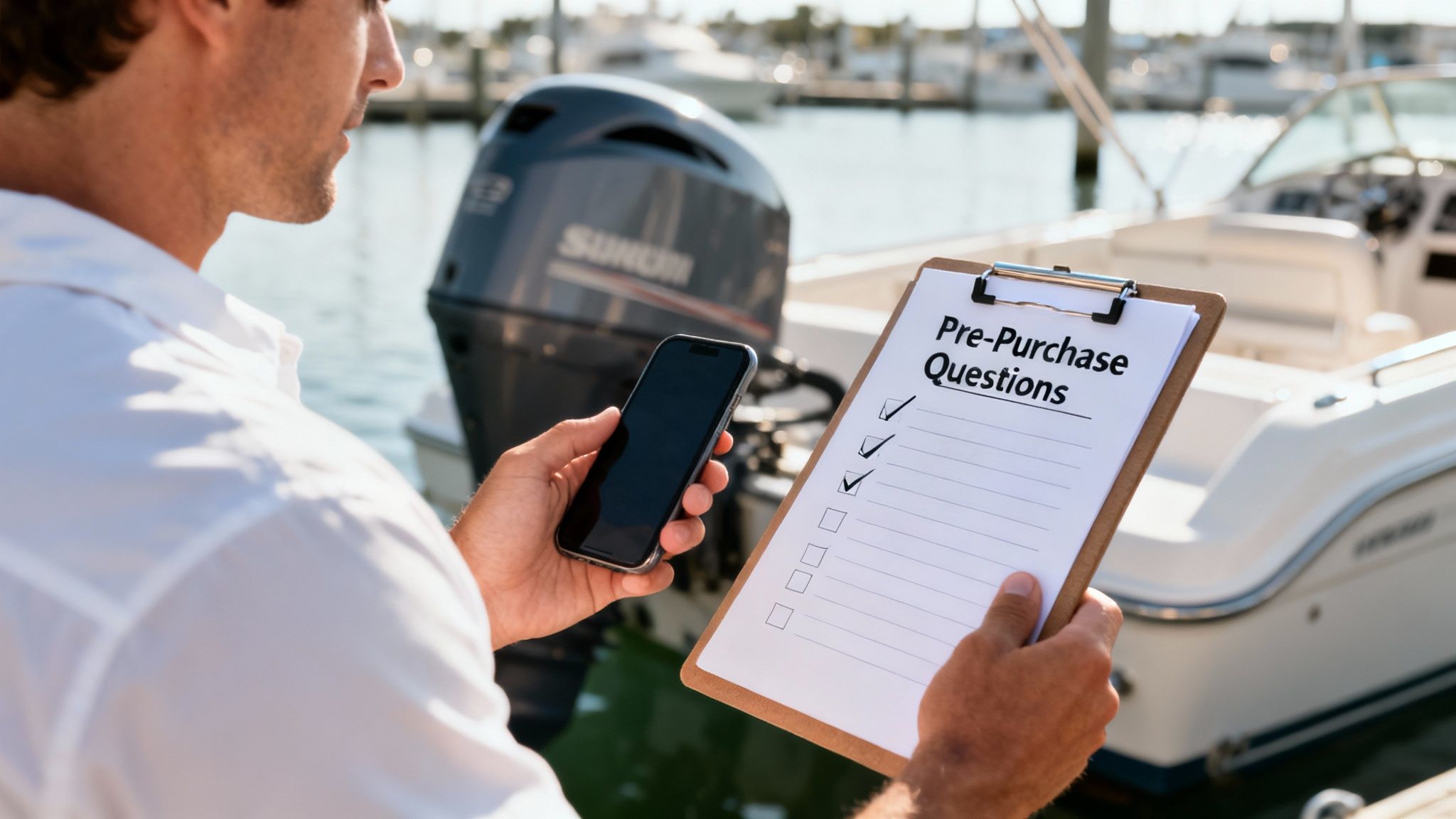
Before you even think about grabbing your keys or kicking a tyre, a quick phone call or email exchange with the seller can save you a world of pain. Don't waste a drop of petrol driving across town for a dud. This first conversation is your best filter—it’s where you gather the critical intel that separates a potential gem from a definite headache.
Think of yourself as a detective. You're asking sharp, specific questions to build a clear picture of the motor's life story, uncovering the details that don't always make it into the online ad.
This initial chat is all about due diligence. The right questions will tell you almost everything you need to know about the motor's history and the owner's attitude toward maintenance. Use this table as your script to vet sellers efficiently.
| Question Category | Specific Question to Ask | What the Answer Reveals (Green Flag vs. Red Flag) |
|---|---|---|
| Usage History | "Has this motor been used in freshwater, saltwater, or a mix of both?" | Green Flag: Primarily freshwater use. Red Flag: Heavy saltwater use with no mention of regular flushing. |
| Service Records | "Do you have service receipts or a logbook? Who did the servicing?" | Green Flag: A neat folder of receipts from a marine mechanic. Red Flag: Vague answers, no records, or claims of "serviced it myself" with no proof. |
| Reason for Selling | "Just curious, what’s the reason you’re selling it?" | Green Flag: Legitimate reasons like "upgrading to a bigger boat" or "don't use it anymore." Red Flag: Hesitation or a story that doesn't add up. |
| Running Hours | "How many hours are on the engine? Does it have an hour meter, or can you get a printout?" | Green Flag: A clear number supported by an ECU printout or a working meter. Red Flag: A wild guess or "not many" without any evidence. |
| Storage & Fuel | "How was it stored when not in use, and was the fuel system prepared for storage?" | Green Flag: Stored under cover, fuel stabiliser used, or fuel drained. Red Flag: Left out in the elements, old fuel sitting in the tank for years. |
| Known Issues | "Are there any known issues, quirks, or things I should be aware of?" | Green Flag: An honest seller who points out a minor cosmetic issue or a known quirk. Red Flag: The classic "runs perfectly, no issues at all" answer, which is rarely true for a used motor. |
By running through these questions, you'll quickly gauge whether the seller is transparent and if the motor is even worth seeing in person. Trust your gut—if something feels off, it probably is.
Let's break down why some of those questions are so crucial. First up: where has this motor spent its life? A motor used exclusively in freshwater is going to have far less corrosion than one that’s been battling the harsh saltwater environment of the Aussie coast. The difference is night and day and will directly impact its lifespan and your future maintenance bills.
Next, you absolutely must understand its service history. This is non-negotiable.
Knowing the service background gives you a solid foundation for judging the motor's condition before you lay eyes on it. It also helps you anticipate potential problems. For instance, if a motor has been sitting idle for a long time, its fuel system might be in rough shape. It's a good idea to know what to look for with an outboard engine fuel line to ensure it's not cracked or perished.
Beyond the mechanical side, pay close attention to the human element. Why are they really selling it? An answer like "upgrading to a bigger boat" or "selling the tinny" makes perfect sense. But if the seller is cagey or their story feels flimsy, trust your instincts.
A seller who is open, honest, and can provide detailed answers is precisely the person you want to buy from. Their transparency often reflects how well they’ve cared for the motor itself.
Similarly, try to pin down the true number of running hours. On newer models, this data can often be pulled directly from the engine's computer (ECU). For older motors without an hour meter, you have to rely on the seller's estimate and your own judgement during the physical inspection.
This pre-purchase diligence is your best defence. It ensures you focus your time and energy only on the used outboard boat motors that are genuinely worth considering.
Alright, you’ve done the phone work and found a motor that sounds promising. Now it’s time to get your hands dirty. The in-person inspection is where the seller’s story gets put to the test and you uncover what’s really going on with that engine. This isn’t just kicking the tyres; it's a methodical check that could save you from a world of hurt and a very expensive mistake.
You don't need to be a career marine mechanic to spot the major red flags. Armed with a good torch, a few basic tools, and a sharp eye, you can confidently size up any used outboard and walk away knowing exactly what you’re getting yourself into.
First impressions mean a lot. Start with a slow, deliberate walk-around, just taking in the motor's overall cosmetic state. A few scuffs and faded decals are completely normal for a used motor. But keep an eye out for deep gouges, significant paint bubbling, or heavy corrosion—these are tell-tale signs of a hard life or serious neglect.
Zero in on these specific areas:
Okay, time to pop the cowling off. This is where the real deal-breakers are hiding. The inside of the engine bay should be reasonably clean for its age. A light film of oil is fine, but if you see thick, greasy gunk everywhere, you’re likely looking at leaks.
Get your torch out and have a good look at the wiring. You’re searching for anything that looks burnt, brittle, or has dodgy-looking repairs wrapped in electrical tape. Tidy, well-organised wiring is a fantastic sign of a motor that's been looked after. If it's a four-stroke, pull the dipstick and check the oil. It should be a honey or dark brown colour. If it looks milky, like a flat white coffee, that's a massive red flag. It means water is getting into the engine.
The infographic below gives you a rundown of the most common problems we see during inspections, so you know exactly what to keep an eye out for.
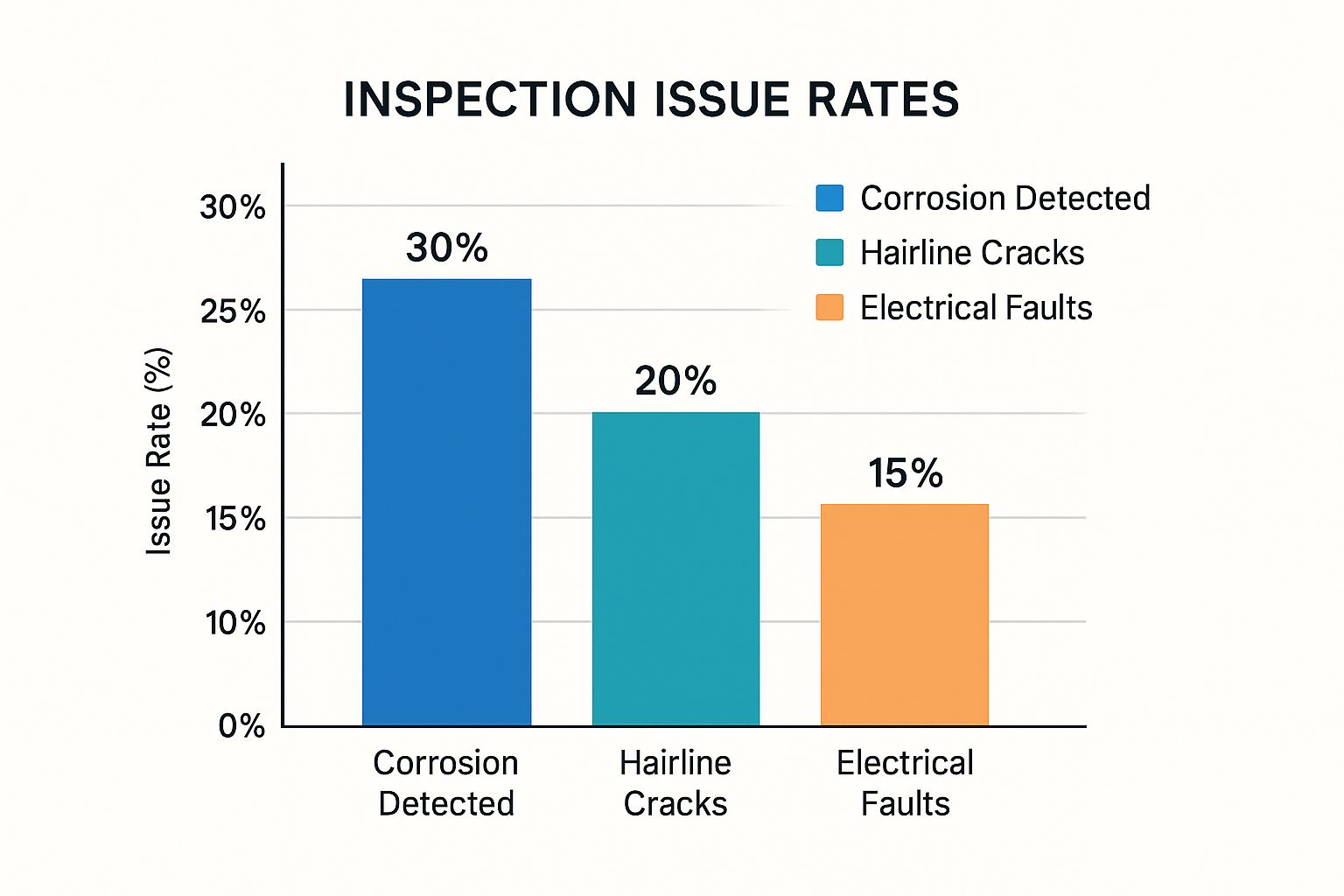
As the data shows, corrosion is the number one issue. That’s why it’s so important to check for rust and salt build-up everywhere, especially in those hard-to-see spots.
If there's one test that tells you the most about an engine's internal health, it's a compression test. It measures how well each cylinder holds pressure, giving you a direct snapshot of the condition of the pistons, rings, and valves. It's a surprisingly simple test you can do yourself with a basic compression tester from any auto parts store.
To run the test, you’ll need to remove all the spark plugs. Screw the tester into one of the spark plug holes. With the throttle held wide open, crank the engine over a few times until the needle on the gauge stops climbing. Jot down the reading, and then repeat the process for all the other cylinders.
What the numbers mean: You’re looking for two things here: strong pressure and, more importantly, consistency. Ideally, all cylinders should be within 10-15% of each other. If you find one cylinder with a reading that’s way lower than the others, it’s a sure sign of a serious internal problem.
This hands-on approach is absolutely critical, whether you're pairing a motor with a small tender or fitting out one of the many popular small fishing boats you see all over Australia. The massive demand from anglers and recreational boaters drives the second-hand market. In fact, Australia's marine industry had a turnover of AUD 8.835 billion in 2020-21, and used outboards made up a significant chunk—around 15%—of dealer sales revenue. A proper inspection is your best insurance against buying a dud.
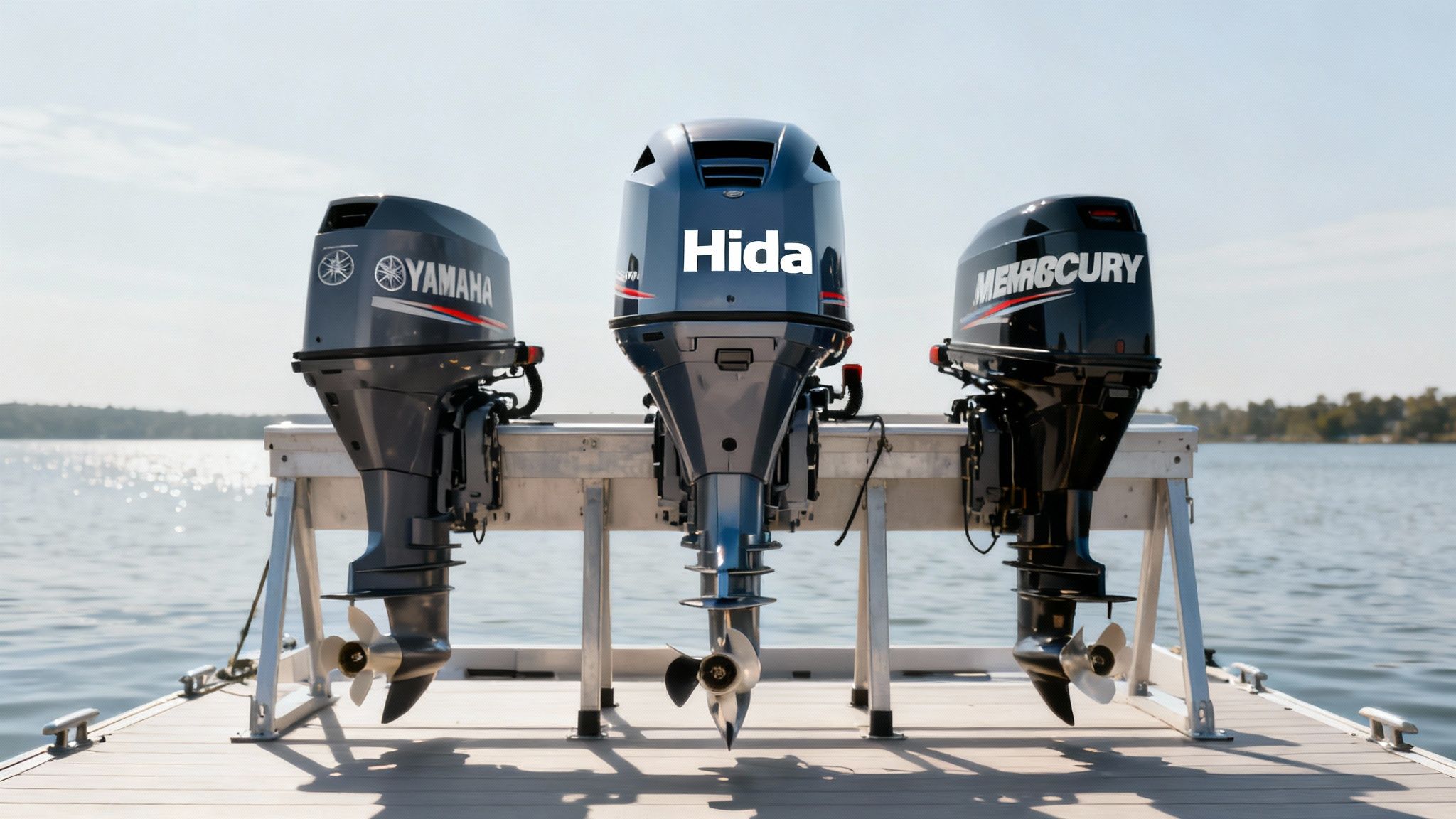
When you start browsing listings for used outboard boat motors, you’ll quickly notice a pattern. The same big names—Yamaha, Mercury, Suzuki—tend to dominate the results. While these are excellent brands, focusing only on them means you might miss out on one of the smartest buys on the second-hand market: a used Hidea outboard.
Hidea has carved out a strong reputation for producing robust, no-nonsense motors that offer exceptional value. This value proposition becomes even more compelling when you're looking at pre-owned models. Let's dig into why a used Hidea deserves a top spot on your inspection list.
One of the greatest strengths of Hidea outboards is their straightforward design. Many of their models, especially in the smaller to mid-horsepower ranges, are built with proven, reliable engineering that avoids overly complex and sensitive electronics. This is a deliberate design choice that pays dividends for the second-hand buyer.
This simplicity is a massive advantage in a used motor. Fewer digital systems mean fewer things that can go wrong down the line. It's a return to the basics of what makes an outboard dependable: strong mechanicals and a design that’s easy for owners or your local mechanic to service.
For a budget-conscious boater, a motor with fewer things that can go wrong is a huge win. A used Hidea often represents a more predictable and less costly ownership experience compared to a high-tech motor with a mysterious past.
The Australian boating scene has been heavily influenced by a push towards engine modernisation. Many boat owners are replacing older two-strokes with newer four-stroke models to meet emission standards and boost fuel economy, which constantly fuels the used market. This replacement cycle is a perfect opportunity for brands like Hidea, which offer cost-effective and modern alternatives. For those interested in the details, you can find more information about these Australian market trends at Mordor Intelligence.
Here’s the simple maths: Hidea outboards are more affordable new. That price advantage translates directly into the used market, allowing your dollar to go significantly further.
For the same money you might spend on an older, high-hour motor from a premium brand, you can often find a much newer Hidea with far fewer hours on the clock. This means you’re not just saving money; you’re buying a motor with more life left in it. You can explore the value-driven approach of Hidea outboard motors to see how they pack in features without the hefty price tag.
Think about this real-world scenario:
Both might be listed for a similar price, but Option B gives you a newer engine that has seen significantly less use, reducing the likelihood of wear-related issues showing up anytime soon.
When you're actively comparing listings, it helps to see the differences side-by-side. While every used motor must be judged on its individual condition, some general trends make Hidea a seriously compelling choice for savvy buyers in Australia. This is where Hidea truly stands out from the crown of competitors.
This table breaks down the key decision factors.
| Feature | Used Hidea Outboards | Used Yamaha/Mercury/Suzuki |
|---|---|---|
| Value for Money | Excellent. You can typically get a newer model with lower hours for the same price as an older competitor. | Good to Fair. Strong brand recognition keeps resale values high, meaning you often pay more for an older engine. |
| Technology & Complexity | Simpler Design. Generally features less complex electronics, leading to easier DIY maintenance and potentially fewer electrical faults. This is a key advantage for long-term reliability. | More Complex. Often includes advanced electronics and computer systems that can be costly to diagnose and repair out of warranty. |
| Parts & Service | Readily Available. Parts are accessible and often more affordable. Service can be done by most competent marine mechanics. | Widely Available. Extensive dealer network, but genuine parts can be more expensive. |
Ultimately, choosing a used Hidea is a practical decision. It's for the boater who prioritises reliability and low running costs over brand prestige, securing a dependable motor without overspending. It's a smart, pragmatic choice that gets you on the water with less fuss.
You’ve done the hard yards with the inspection, and the motor looks like a winner. Now comes the part that makes a lot of people nervous: talking money.
Negotiating doesn’t have to be some awkward showdown. Think of it as a calm conversation where you use what you’ve learned to agree on a price that’s fair for both you and the seller.
This is where your detailed inspection becomes your trump card. The goal isn’t to lowball the seller into submission, but to present legitimate, fact-based reasons for your offer. Those minor issues you spotted? They’re now your polite, factual leverage points.
The best way to start is by acknowledging the good points of the motor before you gently introduce your concerns. This shows you’re a serious buyer, not just a tyre-kicker looking for an excuse to knock the price down.
Frame your points clearly and calmly. You’re just stating facts.
Example 1: A Worn Propeller
"The motor is in great nick overall, but I did notice the propeller has a few significant dings. A replacement prop will be one of the first things I'll need to sort out, which adds to the initial cost."
Example 2: Minor Corrosion
"It runs well, but there is some noticeable corrosion starting on the mounting bracket bolts. It's not a deal-breaker, but it's something I'll need to address straight away to stop it from getting worse."
This approach justifies your offer and makes it feel reasonable, not just a number you pulled out of thin air. It's a discussion, not a demand.
The key is to be fair and transparent. Presenting your findings calmly demonstrates that your offer is based on the motor's actual condition, making it much harder for a seller to dismiss.
Once you've settled on a price, there are a few final steps that are absolutely essential to protect yourself. Never, ever hand over cash without getting the proper paperwork in order. This isn't just about a receipt; it's about making sure your new purchase is legally yours.
A crucial step is to run a Personal Property Securities Register (PPSR) check using the motor’s serial number. This quick online search confirms there’s no money owing on the motor. The last thing you want is to buy an engine that could be repossessed because the previous owner defaulted on a loan.
Finally, insist on a detailed bill of sale. It should include:
This document is your proof of ownership. Don’t finalise the deal without it.
Negotiating prices for motors can be tricky, so it helps to research what similar models are selling for. You can learn more about factors that affect pricing by reviewing guides on new and used Mercury outboard motor pricing to get a better baseline.
Stepping into the used outboard market can feel a bit daunting, and it's natural to have questions. Everyone does. We get asked a lot about what to look for, so we've put together answers to the most common queries to help you buy with total confidence.
Honestly, the service history will always tell you more than the hour meter. I’d take a perfectly maintained 1,000-hour motor over a neglected 300-hour one any day of the week. But, if you need a rough guide for a modern four-stroke, here's what the numbers generally mean:
Remember, hours are just one piece of the puzzle. A verifiable, consistent service record is king—prioritise that over low hours with a murky past.
If you're not 100% confident in your own mechanical skills, or you're looking at a motor that costs a fair chunk of change (anything over $5,000 is a good rule of thumb), then yes—hiring a qualified marine mechanic is one of the smartest things you can do.
A professional inspection might set you back a few hundred dollars, but think of it as an investment in peace of mind. A good mechanic has diagnostic tools you don't, can spot subtle issues like the first signs of internal corrosion, and will give you an expert opinion that could save you thousands down the track.
Buying from a private seller is almost always going to be cheaper upfront, but it comes with a trade-off: more risk. When you buy from a dealer, you're paying a premium for a bit of security. They might offer a short-term warranty, and they have a business reputation to protect.
With a private sale, the responsibility for a thorough inspection rests entirely on you. You need to be diligent. Make sure you get a detailed bill of sale and always, always verify the seller actually owns the motor before any money changes hands. It's the path to the best savings, but it demands the most homework.
Ready to find the perfect motor for your inflatable boat? At Easy Inflatables, we are authorised Hidea dealers and can package a reliable outboard with one of our premium Aerowave boats to create the ultimate turnkey rig. Explore your options today at https://easyinflatables.com.au.
Experience the ultimate freedom on the water with our top-quality inflatable boats and accessories. Easy Inflatables is your trusted partner, providing everything you need for a safe and unforgettable adventure.
At Easy Inflatables, we believe in empowering adventurers with high-quality inflatable solutions. Our commitment to durability and performance ensures that every product enhances your outdoor experiences.